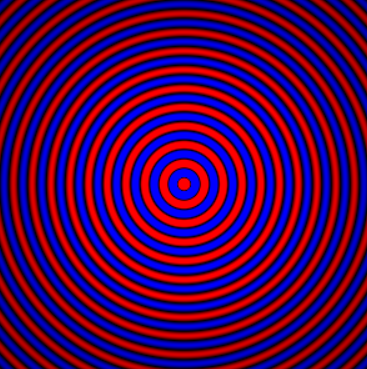Circular waves
Two dimensional circular waves move along a surface or an interface. If a rod that extends through the surface of water is pushed up and down with a frequency $\omega$, ciruclar waves will be generated that have the form,
$$u(\vec{r},t)=\frac{A\cos (k|\vec{r}-\vec{r}_s|-\omega t +\varphi)}{\sqrt{|\vec{r}-\vec{r}_s|}}$$
Here $u(\vec{r},t)$ is the displacement from the undisturbed surface measured perpendicular to the surface, $A/\sqrt{|\vec{r}-\vec{r}_s|}$ is the amplitude, $k=\frac{2\pi}{\lambda}$ is the wavenumber, $\lambda$ is the wavelength, $\vec{r}_s$ is the position of the wave source, $\omega$ is the angular frequency, and $\varphi$ is the phase.
If the speed of the waves $c$ is known, the wavenumber can be determined by $k=\frac{\omega}{c}$. The frequency of the oscillations is the same at every point but the amplitude decreases with distance from the source. The power transmitted by the waves is constant through every ring around the source.
A point source in three dimensions emits spherical waves of the form,
$$u(\vec{r},t)=\frac{A\cos (k|\vec{r}-\vec{r}_s|-\omega t +\phi)}{|\vec{r}-\vec{r}_s|}.$$Here the amplitude falls more quickly with distance than in the two-dimensional case. The power transmitted by the waves through every spherical shell around the source remains constant.